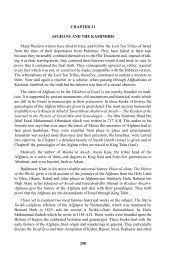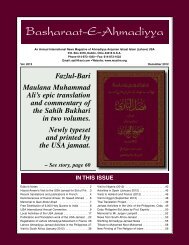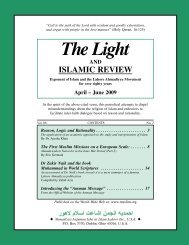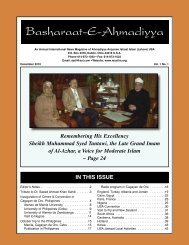From Arabia to the Himalayas - The Lahore Ahmadiyya Movement in ...
From Arabia to the Himalayas - The Lahore Ahmadiyya Movement in ...
From Arabia to the Himalayas - The Lahore Ahmadiyya Movement in ...
You also want an ePaper? Increase the reach of your titles
YUMPU automatically turns print PDFs into web optimized ePapers that Google loves.
LAHORE AHMADIYYA MOVEMENT AND ALBANIA IN INTER-WAR PERIOD 4<br />
spiritual head, and of a booklet by Khwaja Kamaludd<strong>in</strong>. 15 Lastly, four issues of a small<br />
journal describ<strong>in</strong>g itself as <strong>the</strong> Albanian-language supplement of <strong>the</strong> <strong>Lahore</strong> journal <strong>The</strong> Light<br />
appeared <strong>in</strong> 1936, <strong>the</strong>reby offer<strong>in</strong>g <strong>the</strong> Albanian public still fur<strong>the</strong>r access — direct or <strong>in</strong>direct<br />
— <strong>to</strong> <strong>the</strong> Anjuman’s works. 16<br />
What was <strong>the</strong> subject matter of <strong>the</strong>se texts drawn from or <strong>in</strong>spired by <strong>the</strong> Lahori<br />
Ahmadi corpus? We can dist<strong>in</strong>guish four major categories. Many are concerned with <strong>the</strong><br />
Muslim faith <strong>in</strong> general, with <strong>the</strong> personality of <strong>the</strong> Prophet and with <strong>the</strong> Holy Book of Islam,<br />
<strong>the</strong> Koran, from a reformist perspective. O<strong>the</strong>rs deal with <strong>the</strong> role of Islam <strong>in</strong> modern society.<br />
On this <strong>to</strong>pic, two <strong>the</strong>mes crop up most frequently: <strong>the</strong> condition of women and Islam’s<br />
freedom from <strong>in</strong>compatibility with science, education and progress. Women do not have <strong>to</strong> be<br />
veiled. <strong>The</strong>y should receive school<strong>in</strong>g. Islam does not forbid pho<strong>to</strong>graphy, <strong>the</strong> Koran may be<br />
broadcast over <strong>the</strong> radio, and Muslims need <strong>to</strong> be educated. A third group consists of texts<br />
aim<strong>in</strong>g <strong>to</strong> reassert <strong>the</strong> value of Islam <strong>in</strong> relation <strong>to</strong> <strong>the</strong> West and Christianity. In <strong>the</strong>se, an<br />
appeal is made <strong>to</strong> <strong>the</strong> greatness of <strong>the</strong> Muslim world dur<strong>in</strong>g <strong>the</strong> Middle Ages, <strong>to</strong> <strong>the</strong><br />
superiority of Muslim Spa<strong>in</strong> compared with a barbarous West, or else <strong>to</strong> bro<strong>the</strong>rhood <strong>in</strong><br />
Islam. Positive appreciations of Islam by Christians and o<strong>the</strong>r non-Muslims are adduced, and<br />
above all <strong>the</strong> conversion of Europeans. Islam’s worldwide numerical strength is underscored<br />
by way of statistical tables, and more precise facts are given about <strong>the</strong> Islamic communities of<br />
Europe, Japan and America. To this group should be added texts that reassert <strong>the</strong> value not<br />
only of Islam, but also of religion <strong>in</strong> general, <strong>in</strong> opposition <strong>to</strong> materialism and a<strong>the</strong>ism. Lastly,<br />
<strong>the</strong> fourth category is that of <strong>the</strong> texts that more specifically concern <strong>the</strong> <strong>Ahmadiyya</strong><br />
<strong>Movement</strong>, its missions and <strong>the</strong>ir activities, with <strong>the</strong> emphasis on <strong>the</strong> expansion of Islam <strong>in</strong><br />
Europe.<br />
In order <strong>to</strong> gauge <strong>the</strong> Anjuman’s <strong>in</strong>fluence, it is also <strong>in</strong>terest<strong>in</strong>g <strong>to</strong> enquire <strong>in</strong><strong>to</strong> <strong>the</strong><br />
transla<strong>to</strong>rs of <strong>the</strong>se texts. For that, it is necessary <strong>to</strong> draw a dist<strong>in</strong>ction between two periods.<br />
Between 1927 and 1931, <strong>the</strong> Ahmadi texts are translated by two people <strong>in</strong> <strong>the</strong> ma<strong>in</strong>: <strong>the</strong><br />
Adm<strong>in</strong>istrative Direc<strong>to</strong>r and lecturer at <strong>the</strong> Medrese of Tirana, Junus Bulej, 17 who generally<br />
translated from German and, from 1929 onwards, <strong>the</strong> young Professor of Ma<strong>the</strong>matics and<br />
Chemistry at <strong>the</strong> American Technical College <strong>in</strong> Tirana, Omer (or Ymer) M. Sharra, 18 who<br />
translated from English. 19 No ulema were <strong>in</strong>volved, <strong>the</strong>refore. One can assume that <strong>the</strong>y had<br />
been more or less appo<strong>in</strong>ted <strong>to</strong> translate <strong>the</strong> Ahmadi texts by members of <strong>the</strong> leadership of <strong>the</strong><br />
Islamic Community. But, be<strong>in</strong>g a teacher at <strong>the</strong> Medrese, Junus Bulej seems <strong>to</strong> have had his<br />
imita<strong>to</strong>rs among <strong>the</strong> students, all <strong>the</strong> more so as it became, <strong>in</strong> <strong>the</strong> 1930’s, part of <strong>the</strong> education<br />
of <strong>the</strong> religious authorities-<strong>to</strong>-be tra<strong>in</strong>ed <strong>in</strong> that establishment <strong>to</strong> use and <strong>to</strong> translate Ahmadi<br />
literature.<br />
Follow<strong>in</strong>g <strong>the</strong> 1929 Congress, <strong>the</strong> Albanian Islamic Community and its <strong>in</strong>stitutions<br />
were <strong>in</strong>deed reformed, particularly <strong>the</strong> Medrese of Tirana, which became <strong>the</strong> sole<br />
establishment for Muslim religious education <strong>in</strong> <strong>the</strong> country, under <strong>the</strong> name ‘Medrese<br />
15 Muhamet Ali, Një përshkrim i shkurtër i jetës së profitit t’islamizmës (trans. Omer M. Sharra), Shkodër, ‘Ora e<br />
Shkodrës’, 1929, 74 pp.; Muhamet Ali, Muhamedi profeti i ynë, Shkodër, ‘Ora e Shkodrës’, 1931, 247 pp.; and<br />
Disa të vërteta morale (trans. Sh. Putra), Tirana, ‘Tirana’, 1939, 45 pp. It is possible that <strong>the</strong> booklet entitled<br />
Islamizmi, published by <strong>the</strong> Islamic Community <strong>in</strong> 1929, is also translated from an Ahmadi text. I have not been<br />
able <strong>to</strong> check this. In addition, it is necessary <strong>to</strong> po<strong>in</strong>t out that <strong>the</strong>re were, <strong>in</strong> 1935 and 1938, two translations of<br />
works by Ömer Rıza Doğrul, a Turkish author himself steeped <strong>in</strong> Ahmadi texts, who translated <strong>the</strong> translation of<br />
<strong>the</strong> Koran prepared by Muhammad Ali (cf. Uzun, 1994 on this <strong>in</strong>dividual).<br />
16 On this periodical, see below.<br />
17 On Junus Bulej (1892–1966), orig<strong>in</strong>ally from Shkodra, cf. Luli-Dizdari-Bushati 1997, pp. 399–414.<br />
18 On Ymer Sharra (1901–1975), who was born <strong>in</strong> Vlora (<strong>in</strong> South-West Albania), see Gogaj 1999, p. 54.<br />
19 Accord<strong>in</strong>g <strong>to</strong> <strong>the</strong> United States reissue of <strong>the</strong> book Muhamet Ali, Një përshkrim i shkurtër i jetës së profitit<br />
t’islamizmës, translated by Omer M. Sharra, which Imam Vehbi Ismaili has made available <strong>to</strong> me, Omer Sharra<br />
was at that time Professor of English at <strong>the</strong> Medrese of Tirana. I am immensely grateful <strong>to</strong> Imam Vehbi Ismail,<br />
who was k<strong>in</strong>d enough <strong>to</strong> reply <strong>to</strong> my queries and send me publications.



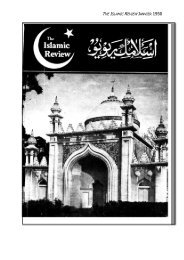
![Part 2] HARD TRIALS NECESSARY TO ESTABLISH TRUTH 69 152 ...](https://img.yumpu.com/11777151/1/167x260/part-2-hard-trials-necessary-to-establish-truth-69-152-.jpg?quality=85)

